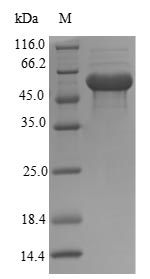This recombinant mouse Thioredoxin-interacting protein (Txnip) gets expressed in E.coli with an N-terminal 6xHis-B2M tag, which makes purification and detection pretty straightforward in experimental protocols. The protein contains the full-length sequence (1-397aa) and shows a purity level that exceeds 90%, confirmed through SDS-PAGE analysis. Built for research applications, this product keeps endotoxin levels low, which should support reliable and reproducible results across different experimental setups.
Thioredoxin-interacting protein (Txnip) appears to play a critical role in how cells regulate redox balance by blocking thioredoxin activity. This interaction likely impacts how cells respond to oxidative stress. Txnip seems to be involved in several biological pathways - glucose metabolism and apoptosis among them. Researchers studying how cells react to metabolic and oxidative stress often focus on this protein, as it may contribute to our understanding of both normal physiological processes and disease states.
Potential Applications
Note: The applications listed below are based on what we know about this protein's biological functions, published research, and experience from experts in the field. However, we haven't fully tested all of these applications ourselves yet. We'd recommend running some preliminary tests first to make sure they work for your specific research goals.
The mouse Txnip is a eukaryotic protein that requires correct folding and disulfide bond formation for its function in redox regulation and protein interactions (particularly with thioredoxin). E. coli, as a prokaryotic system, lacks the eukaryotic chaperones and may not facilitate proper disulfide bond formation in the reducing cytoplasm. The large B2M tag (≈12 kDa) may sterically hinder proper folding or interaction interfaces. Without experimental validation (e.g., thioredoxin binding assays or structural analysis), the protein cannot be assumed to be correctly folded or bioactive. The high purity indicates low impurities, but does not guarantee native conformation.
1. Protein-Protein Interaction Studies Using Pull-Down Assays
The His-B2M tag enables pull-down assays to identify binding partners. However, if Txnip is misfolded, interactions may be non-physiological. The B2M tag itself might cause steric hindrance or non-specific binding. Validate any identified interactions (especially with thioredoxin) using co-immunoprecipitation of endogenous proteins from mouse cells or tissues.
2. Antibody Development and Validation
This application is suitable. The recombinant Txnip can serve as an immunogen for generating antibodies against linear epitopes, even if misfolded. The high purity supports consistent immunization. However, antibodies generated may not recognize conformational epitopes of native Txnip. Validate antibody specificity against endogenous Txnip in mouse cell or tissue lysates.
3. Biochemical Characterization and Stability Studies
This recombinant mouse Txnip is suitable for basic biophysical characterization (e.g., thermal stability, aggregation propensity). However, data may not reflect native Txnip properties due to potential misfolding and the large B2M tag. Use techniques like circular dichroism to assess secondary structure, but interpret results cautiously without native Txnip controls.
4. Competitive Binding Assays and Inhibitor Screening
This application requires a correctly folded Txnip, especially for interactions with thioredoxin. If misfolded, binding assays will not identify physiologically relevant inhibitors. First, validate Txnip's ability to bind thioredoxin in a functional assay before screening inhibitors. The B2M tag may interfere with the thioredoxin-binding interface.
Final Recommendation & Action Plan
Before using this recombinant Txnip for functional studies, validate its folding and thioredoxin-binding capability. Start with a thioredoxin binding assay (e.g., co-immunoprecipitation or surface plasmon resonance) and a structural check (e.g., circular dichroism spectroscopy). If functional, proceed with interaction or inhibitor studies; if not, limit use to antibody production (with validation against native Txnip). For reliable results, consider expressing Txnip in a eukaryotic system (e.g., mammalian cells) that supports proper folding and disulfide bond formation. Always include controls with native Txnip when possible.






